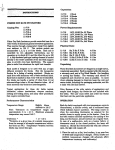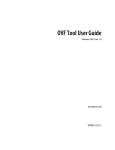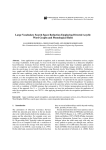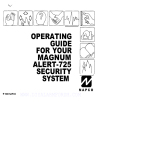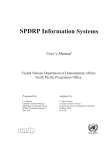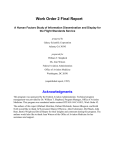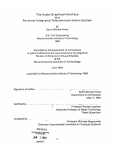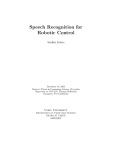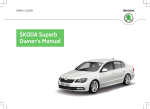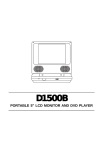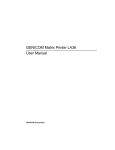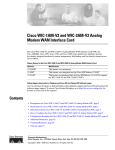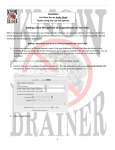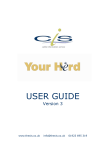Download View/Open - Calhoun: The NPS
Transcript
: NAVAL POSTGRADUATE SCHOOL Monterey , California THESIS •&&Z37 SPEECH RECOGNITION AND THE TELECOMMUNICATIONS EMERGENCY DECISION SUPPORT SYSTEM by Nancy C. Browne MARCH l 9 9l" e Thesis Advisor Co-Advisor Daniel R. Dolk Gary K. Poock Approved for public release: Distribution is unlimited T253949 Unclassified SECURfTY CLASSIFICATION OF THIS PAGE Form Approved REPORT DOCUMENTATION PAGE REPORT SECURrTY CLASSIFICATION 1a. OMB No 1b. 0704-0188 RESTRICTIVE MARKINGS Unclassified 2a SECURfTY CLASSIFICATION AUTHORrTY 3. PERFORMING ORGANIZATION REPORT NUMBER(S) NAME OF PERFORMING ORGANIZATION 6a. 5 6b OFFICE (If Naval Postgraduate ADDRESS 6c. Set: ADDRESS 8b OFFICE (If 1 1 TrTLE (Include Security Classification) 12. PERSONAL AUTHORS (City, State, and ZIP Code) Monterey, CA SYMBOL 9 PROCUREMENT INSTRUMENT 93943-5000 IDENTIFICATION NUMBER applicable) and ZIP Code) (City, State, ADDRESS 93943-5000 ORGANIZATION NAME OF MONITORING ORGANIZATION Naval Postgraduate School AS ool NAME OF FUNDING/SPONSORING 8c. 7a. 7b Monterey, CA 8a. SYMBOL MONfTORING ORGANIZATION REPORT NUMBER(S) applicable) and ZIP Code) State (City, REPORT Approved for public release Distribution is unlimited DECLASSIFICATION/DOWNGRADING SCHEDULE 2b. 4 DISTRIBUTION/AVAILABILrTY OF 10 SOURCE OF FUNDING NUMBER PROGRAM PROJECT TASK WORK ELEMENT NO NO NO ACCESSION NO UNn" SPEECH RECOGNITION AND THE TELECOMMUNICATIONS EMERGENCY DECISION SUPPORT SYSTEM NANCY 13a. BROWNE C. TYPE OF REPORT 13b TIME COVERED FROM Master's Thesis 14. TO DATE OF REPORT (Year, Month, Day) 15 PAGE COUNT 54 MARCH 19 91 SUPPLEMENTARY NOTATION 16 The views expressed are those of the author and do not reflect the official policy or position of the Department of Defense or the U.S. Government COSATI CODES 17 GROUP FIELD ABSTRACT 19. 18 (Continue SUBJECT TERMS if necessary and if necessary and identify by block numbers) Speech recognition SUB-GROUP on reverse (Continue on reverse identify by block numbers) purpose of this thesis is to provide a feasibility study for incorporating speech recognition into the Telecommunications Emergency Decision Support System (TEDSS) developed by the National Communications System (NCS) and contained on a Compaq 386. The three types of speech recognition systems that were used are: the DragonDictate, a software driven system, the Verbex Series 5000, a system contained in a peripheral device, and the KeyTronic Speech Recognition System, a system contained in a keyboard in addition to using speech software. A prototype was developed using the speech systems to determine whether or not TEDSS could be combined successfully with speech recognition. The results indicate that the incorporation of speech recognition into TEDSS is possible with some modifications to TEDSS software and to the Compaq The 386. DISTRIBUTION/AVAILABILrTY OF 20. XX UNCLASSIFIED/UNLIMfTED 22a NAME OF RESPONSIBLE ABSTRACT SAME AS RPT P1. DTIC INDIVIDUAL 22b Daniel R. Dolk DD Form 1473, JUN 86 ABSTRACT SECURfTY CLASSIFICATION unclassified USERS TELEPHONE (Include Area (408) Previous editions are obsolete. S/N 0102-LF-014-6603 i Code) 646-2260 22c OFFICE SYMBOL AS/DK SECURfTY CLASSIFICATION OF THIS PAGE Unclassified Approved for public release: Distribution is unlimited Speech Recognition and the Telecommunications Emergency Decision Support System by Nancy C. Browne Captain, United: States Army B.A., Northeastern University M.S.B., Troy State University Submitted in partial fulfillment of the requirements for the degree of MASTER OF SCIENCE IN INFORMATION SYSTEMS from the NAVAL POSTGRADUATE SCHOOL MARCH 1991 /7 David R. Wiippi-er-N Chairman Administration^Sciences 11 ABSTRACT The purpose of this thesis is to provide study incorporating for feasibility a recognition speech into the Telecommunications Emergency Decision Support System (TEDSS) developed by contained the on a National Compaq Communications three The 386. System types and (NCS) of speech recognition systems that were used are: the DragonDictate, software driven contained in Recognition a system, Verbex the peripheral device, System, a system Series a system and the KeyTronic Speech contained addition to using speech software. 5000, a in a keyboard in A prototype was developed using the speech systems to determine whether or not TEDSS could be combined successfully with speech recognition. The results indicate that the incorporation of speech recognition into TEDSS is possible with software and to the Compaq 386. in some modifications to TEDSS . Li TABLE OF CONTENTS I. INTRODUCTION 1 1 B. BACKGROUND THE PROBLEM C. SPEECH RECOGNITION TECHNOLOGY 2 A. 1 METHODOLOGY E. SCOPE OF THE PROBLEM F. STRUCTURE OF THE THESIS TEDSS ARCHITECTURE AND CAPABILITIES D. II. A. B. 2 3 4 5 BACKGROUND SYSTEM FUNCTIONS 1 5 6 Telecommunications Emergency Activation Documents 8 2 Personnel Management 8 3 Resource Management 9 4. Damage Assessment 5. Requirements Management a. Enter 10 (Claims) service a or .... facility request b. Review 12 and resolve service or facility requests c. Review iournaled 13 service facility requests C. III. or 13 6. Message support 13 7. Critical site communication 13 HARDWARE 14 CURRENT SPEECH RECOGNITION TECHNOLOGY A. BACKGROUND B. TYPES OF SPEECH C. 12 CURRENT SYSTEMS 17 17 20 22 IV D. IV. USES IN INDUSTRY DEVELOPMENT OF THE PROTOTYPE A. HARDWARE B. THE SPEECH RECOGNITION SYSTEM C. D. 27 28 . 30 The DragonDictate 2. KeyTronic Speech Recognition Keyboard 3. Verbex Series 5000 INTERFACE INSTRUCTIONS 30 . 31 31 32 1. Operating Within TEDSS 34 2. Summary 36 CONCLUSIONS AND RECOMMENDATIONS A. 27 METHODOLOGY 1 V. 24 CONCLUSIONS 38 38 RECOMMENDATIONS SUGGESTED FUTURE RESEARCH C. LIST OF REFERENCES BIBLIOGRAPHY INITIAL DISTRIBUTION LIST B. v 4 41 42 43 45 LIST OF FIGURES Figure 1. TEDSS Main Menu Figure 2. Telecommunications 7 Emergency Documents Activation 9 Figure 3. Resource Management 10 Figure 4. Damage Assessment 11 Figure 5. Requirements Management 12 Figure 6. 14 Figure Figure 7. Figure 9. Message Support Critical Site Communications MicroVAX II Configuration MS-DOS Partition 8. VI 15 16 28 LIST OF TABLES TABLE I. EXAMPLES OF SPEECH RECOGNITION SYSTEMS VII ... 23 . I A . INTRODUCTION BACKGROUND The National Communications System for coordinating national resources in case of this responsibility, system called Support the System a and is (NCS) responsible telecommunication regional national emergency of any type. To meet NCS developed has Telecommunications (TEDSS) assist to telecommunication resources on a in decision a Emergency support Decision management the of national level. TEDSS will be used in times of national emergency by regional managers who may not have a high degree of computer expertise. B. THE PROBLEM TEDSS provides interactive automated, information processing and decision support to NCS in times of national emergency. The eventual users of TEDSS will be "computer naive" regional managers operating under time constraints in an emergency situation. As a result, they may be reluctant to use a keyboard to interact with TEDSS since it would require time they are not willing to relinquish. Speech recognition is a technology which can reduce interaction and potentially the time and increase TEDSS 1 complexity of usefulness. If speech recognition can be combined with TEDSS, the system may . be accessible more friendly user and under emergency conditions C. SPEECH RECOGNITION TECHNOLOGY The role of speech recognition in desktop computing is not as well established as inventory control, in manuf acturing, etc. where the user's hands and eyes are otherwise occupied. However, the success of speech recognition is predicated on our understanding of what it can and cannot do as it evolves. The critical desirability, of tests reliability, user and cost effectiveness may be met for a number applications understanding practicality, of by today's unpredictable the of Nevertheless, products. human element more must be achieved. Research is currently attempting to do this. It is only by continuing research and development with automatic speech recognition that we can define and refine the work remaining to realize its full potential. D . METHODOLOGY Three types of speech recognition Each represented a stems were tested. different approach to incorporating speech recognition with TEDSS. Dragon Systems, Inc., speech processor • a board The first was the DragonDictate by software driven speech system using installed in a Compaq, and a a head microphone which pluged in to the speech processor board. This software was used to test and verify the speech system's ability to operate a menu-driven application such as TEDSS. The second system was the Verbex Series 5000, by Verbex Voice Systems, device. first space. which is completely self-contained in a peripheral The system represents a hardware alternative to the approach third The significantly requires and was the Key less disk Recognition Speech Tronic hard Keyboard, by KeyTronics, which uses a keyboard as an external device along with the speech software. The speech processor is contained within the keyboard and uses plugs into the keyboard. This a head microphone which alternative was used as a compromise between having the speech system either totally contained internally or contained externally in device. Each system was initially tested as a a peripheral standalone system for familiarization and to determine ease of training. Upon completion, attempts were made to incorporate each system into TEDSS. E. SCOPE OF THE PROBLEM This thesis examines and evaluates each of the three types of speech recognition systems based on their interaction with TEDSS software and the Compaq hardware. used in emergency situations, considered in addition to Since TEDSS will be evaluation criteria that were operational capability include portability, ease of training, and installation requirements, if any. . F. STRUCTURE OF THE THESIS This thesis will review TEDSS and its architecture, current speech recognition technology, and the development of a prototype combining determine the combined successfully the feasibility two. of with The whether speech prototype or not is TEDSS recognition. used to can be Problems resulting from design constraints within TEDSS are identified and addressed along with any hardware constraints within the Compaq. Recommendations for resolution of these problems are included along with suggested areas of research for future theses TEDSS ARCHITECTURE AND CAPABILITIES II. A . BACKGROUND The purpose of TEDSS is to provide automated, interactive decision support to the Office of Manager, NCS, the management telecommunication national of times of national emergency, for (OMNCS) resources in and to support the six federal regions for the management of regional resources. Since user requirements different, TEDSS the accordingly. national the at The operational national information regarding resources on a regional and configuration component the levels deals management of with is are divided high level telecommunication national level, while the regional component is primarily involved with detailed information about regional telecommunication assets. The national Communications resides data Center (NCC) at while the designated copies of National regional data bases are kept on the regionally deployed TEDSS. Each region is required to consequently a be able backup to copy assume of the the duties national of data the NCC, base is contained on each regional system. However, the OMNCS retains control of the update, deletion, and maintenance of the national data base. A regional user can access the national data base using any of the three following methods/ each with its own login and password. • • • B. Regular Operations: day-to-day non-emergency operations What-If: allows regional managers to participate in regional exercises or game-playing. Here the user is allowed to change the national data base but only on a temporary basis. The national data base is later restored to its original state. the regional Emergency: under emergency conditions, manager assumes the role of the national manager and has full read and write access to the national data base. SYSTEM FUNCTIONS There are two versions of TEDSS: one version running on MicroVax II and the other, a "portable" version which runs on a the Compaq 386. Both versions use the Unix operating system. Unix is a multitasking operating system that allows initiate multiple tasks, freely among them. controlled through capabilities. Upon run them concurrently, Access to TEDSS the use of activation, functions log the user to and switch and data and on a is password automatically system requests the user to log on and enter the password. There is no interaction between the user and the Unix operating system outside of TEDSS. through menu-driven within a Interaction with software that hierarchy of menus. TEDSS is accomplished allows the user to move (See Figure 1.) TEDSS provides the user with an on-line help facility to assist with run-time operation of the system. Text defining system operation and . TEDSS MAIN MENU Telecomm Emergency Activation Documents Resource Management Personnel Management Requirements Management Critical Site Communications Message Support (claims) Figure 1 . Damage Assessment TEDSS Main Menu commands is displayed with prompts to allow for continuation screens. The software supports each of the following seven major functional areas: 1. Telecommunications Emergency Activation Documents 2 Personnel Management 3 Resource Management 4 Damage Assessment 5. Requirements Management 6. Message Support 7. Critical Site Communications (claims) Special function keys are provided to facilitate manipulation of prevent accidental corruption of data, the screens, and assist the user in moving between the various functions. The purpose of each these of keys displayed is include: and movement around the TEDSS menu hierarchy, a help facility, a print screen, and data update authorization. 1 Telecommunications Emergency Activation Documents . This function the has capability retrieve to display the Office of Science and Technology Policy Telecommunication Orders (TELORDS) Instructions (TELINSTR) Documents (PEAD) . , , and (OSTP) the NCS Telecommunication and the Presidential Executive Action (See Figure 2.) These documents contain predefined instructions on the roles and responsibilities national review emergency. and the OMNCS during function also allows This update both of the overall current state a of the user to status of the nation's state of emergency and the current status in each of following the Massachetts; six Thomasville, Creek, Michigan; Denver, 2 . Regional Federal Georgia; Denton, Texas; Battle Colorado; Bother, Washington. Personnel Management This option provides a list of all personnel contacted in the event of an emergency such as, contact Maynard, Center: to be points of for the emergency operation center and for various TELECOMM EMERGENCY ACTIVATION DOCUMENTS Emergency Activation Documents Figure 2 . telephone Emergency State of Nation Telecommunications Emergency Activation Documents companies. The user can update or delete the information as necessary. 3 . Resource Management This function enables the user to update and monitor national telecommunication resources. resources are categorized as: (See Figure 3.) Networks, Personnel, These Nodes, Links, Operations Center, Asset Centers, and Assets (general) Based on parameters selected by the user, resources within an area are displayed in . telecommunication a standard format. The locations of the resources can be displayed on a map of the nation by federal region or by state. The parameters can RESOURCE MANAGEMENT Monitor Resources Enter Resources Figure 3 Resource Management : be changed in order to adjust the display. information on a specific resource can If desired, all retrieved and be displayed and, if necessary, updated. 4 . Damage Assessment This is a damage assessment model which simulates a nuclear attack. It enables user the to identify telecommunication resources that may have been damaged in nuclear attack. When a (See Figure 4.) the location and extent of the damage are provided to TEDSS, the status of telecommunications resources affected will be updated to either predicted predicted destroyed. Each report will contain 10 a impaired or summary of the DAMAGE ASSESSMENT Monitor Damage Exexcute Damage Enter Damage Figure 4. Review Journaled Damage Damage Assessment impact of an emergency on the telecommunications resources in the affected area. The assessment capability allows the user to update, execute all of the damage information in the TEDSS data base against all resources, monitor damage to locations and telecommunications resources, and review damage that has been entered into an on-line journal. Damage reports can be provided summarizing the impact on the resources by region or by state and type. the damaged If needed, resources in a a graphical representation of particular area can also be provided. Any damage information which is no longer valid may be sent to a Damage Journal where it may be edited and mapped, or deleted. 11 5. Requirements Management (Claims) Allows the user to enter a request for restoration or augmentation of existing failed telecommunications services such as telephones, networks, Figure 5 . switches, microwave, etc. (See ) REQUIREMENTS MANAGEMENT (claims) Service/Facility Request Service /Facility Request Figure 5 a. Enter All entered into Review Journaled Service/Facility Request Review or resolved Enter a . service or facility request requests the Requirements Management data from NCS member utilizing base provided by the system. TEDSS assigns a a agencies standard may be format unique NCC number to each request, and all requests are maintained in a prioritized order based on predetermined factors. 12 Review and resolve service or facility requests b. This function enables the user to review, edit, and update requests, or resolve claims for service or facilities on any active requests by providing a point of contact resolving for claim. Once resolved, the claim and its resolution a are entered into the system's journal. Review journaled service or facility requests c. This option reviews service or facility requests that have been moved from the active list of requests. These requests can still be edited or deleted, as appropriate. 6. Message support TEDSS provides interactive communication between two enabling users them to receive and send simultaneously through the phone option. information (See Figure 6.) Non-interactive communication allowing users to send mail to other users of the system is provided through the mail option. Upon logging in to the system, a user is notified of any mail received. 7 . Critical site communication This function provides the national manager, regional manager acting as the national manager, ability to network. input engineered networks, and or the the ad hoc generate a new (See Figure 7.) It enables the manager to identify and establish communication between two critical persons or locations. 13 It MESSAGE SUPPORT Telephone Mail Figure 6. Messages Message Support also lists all on-line systems where communication has been established. C. HARDWARE The national level component of TEDDSs is on a MicroVAX II minicomputer which contains the data base manipulated by the INGRES data base m MicroVAX II, a r ; disk in gement Digital Equipment Corporation storage system. (DEC) The computer system, uses the VAX/VMS operating system which is a general purpose operating system. It provides a reliable, high performance environment for the concurrent execution of multiuser timesharing, batch and real-time applications. There are several terminals directly connected to the MicroVAX along 14 CRITICAL SITE COMMUNICATIONS Enter Critical Per sons /Locations Figure with a Monitor Communications Monitor Critical Per sons /Locations 7 . Critical Site Communications magnetic tape drive for back-up and archiving, line printer communications for hard copy reporting. interfaces for the (See Figure peripheral and a 8.) The devices and external communications interfaces are also on the MicroVAX II . The regional TEDSS operating environment is essentially the same as that on the national level. The personal computer used is a Compaq portable 386 linked to a DEC MicroVAX. The TEDSS software is on the MicroVax while the graphics module and the PC/VAX communications software is on the Compaq. The 15 2 TWXIMALJ lAt* DBrv* Figure 8. MicroVAX II Configuration regional components communicate with each other and with the national node via the DECNET communications network. 16 CURRENT SPEECH RECOGNITION TECHNOLOGY III. A . BACKGROUND For a long time, interaction between voice and computing, which can take many general heading of forms, has voice/data been categorized under the integration. narrow This designation usually implies the existence of several digital information streams, some representing voice content and some containing data, physical which have been multiplexed into channel. In reality, range the of a single available technology supporting the interaction of voice and computing is more diverse. three general Voice technologies categories: can be separated into connection control, and software architecture and content processing. Connection control is the arrangement of voice channels to interconnect users and voice equipment. includes telephone signaling arrangements and It point-to-point command links. Software architecture is the organization of computing system software to facilitate the creation of voice-related applications. It includes the abstract modeling of voice resources and distributed access to voice resources. Content processing is the creation, manipulation, and analysis of the information appearing in a voice channel. Speech recognition is included in this category 17 and, for our purposes, we will limit this discussion to speech technologies only. Speech recognition is the capability of recognizing spoken utterances from approximately 43 a given distinct vocabulary sounds set make that There . up our are spoken language. These sounds, known as phonemes, comprise a set of distinct, mutually exclusive speech sounds that may be found in almost any distinguishable spoken phonemes These from each other primarily by the generated frequencies language. by the vocal tract are range during of their production. The air passages above the vocal cords are known collectively as the vocal tract. It extends from the larynx or "voice box" to the lips and includes the entire area of the mouth. "hole" or hollow The vocal tract acts as a resonant area intensifying certain frequencies and weakening others. As speech is generated, the initial sound comes from a vibration in our vocal cords. This sound is generated by the vocal cords rapidly opening and closing with small puffs of air. Some of the phonemes belong to a group called continuants which are sustained sounds such as vowels. because of stable a and These phonemes, lack of vocal tract motion during speech, have constant frequency range throughout a their vocalization. Other classes of phonemes are the plosives and the glides. Plosives are produced by the complete stopping and sudden release of the breath such as "b" in base. The glides are sounds that flow, such as "y" in you. Both plosives and 18 glides are considered to be sounds that normally couple to the surrounding phonemes Diphthongs exist as extreme together. a in They motion when generated as are diphthongs. class of speech sounds characterized by tract vocal resembling manner a coupling the other mouth moves phonemes from one phoneme position to the next during speech, such as the "g" in get or the "w" in will. Since the response time of the muscles within our throat and mouth tend to slur the movement from one spoken phoneme to the many diphthongs next, are generated within our speech patterns. Although the number of phonemes is small, their automated recognition by recently have a computer system is still been there well-defined templates for phonemes. Each phoneme has problem since only a a sound patterns or different duration, and certain vowel sounds can be assigned equally to different phonemes. However, improved technology in phonetic recognition has recently achieved greater degrees of success and higher recognition rates. The patterns phoneme of a language are limited not only by the set of sounds themselves, but also by the allowable combinations. By incorporating rules based on the allowable phoneme combinations in a phonetic recognizer, more robust speech recognition front-ends can be built. The emphasis in speech recognition has been on pattern-matching of word-sized units with those already stored in the data base. The problems insufficient associated speed of with finding digital 19 the processing, best match, have and hindered . progress in Parallel processors and intelligent this area. algorithms that use parallel architectures fully should help to resolve these problems. B. TYPES OF SPEECH The most general forms of speech recognition are speaker- dependent, speaker-independent, discrete speech and continuous speech A speaker-dependent system requires that samples of the user's voice be in memory in order to work properly. Since this system is basically tuned to a particular user's voice, it is easier to recognize than speech which may originate from a variety speech are speaker. of speakers. sensitive This makes a to The parametric the characteristics representations of a of specific set of pattern-matching templates for one speaker perform poorly for another speaker. Consequently, many systems are speaker-dependent, trained for use with each different user. A speaker-independent system contains algorithms which can handle many different voices and diale ' s. Because of these robust algorithms, the system should be able to recognize the voice of anyone who tries to use it. In a discrete speech system, of the user has a given number sound patterns in memory. A sound pattern can be one or several words in a continuous phrase of sound. When using the discrete system, a user must pause about .10 seconds between 20 When the system each utterance made. the pause, 'hears' it knows that was the end of an utterance and therefore starts to search the memory for what was said. just In continuous a speech system, no pause between utterances is required. It is the algorithm recognition the of job determine to word boundaries. Also, coarticulation effects in continuous speech can cause the pronunciation of a word to change depending on position its relative Coarticulation is anticipation statement, following did "What words in sentence. a dependence on the preceding sounds and a the of other to you last do For sounds. example night?" the become, can "Whajedolasnigh?" Additional vocabulary size, vocabulary of affecting factors and environment. grammar, words recognition accuracy. recognition speech be to The recognized size also those are similar to Large vocabularies are more likely to whose the the influences contain ambiguous words than small vocabularies. words of are pattern-matching classification Ambiguous templates algorithm used appear by the recognizer, consequently they are harder to distinguish from each other. In the recognition domain, grammar defines the allowable sequences of words. A tightly constrained grammar is one in which the number of words that can legally follow any given word is known as small. the The amount perplexity of of constraint the 21 grammar. on word choice Systems with is low perplexity are potentially more accurate than those that give the user more freedom. The system can limit effective the vocabulary and search space to those words that can occur in the current input context. Background changes noise, in microphone characteristics, and loudness can all dramatically affect recognition accuracy. Many recognition systems are capable of very low error rates as long as the environmental conditions remain quiet and controlled. However, performance degrades when noise is introduced or when conditions differ from the training session used to build reference the templates. To compensate, the user must almost always wear a head-mounted noise-limiting microphone with the same response characteristics as the microphone used during training. C. CURRENT SYSTEMS Current speech recognition systems can be divided into two primary categories: speaker-independent or speaker-dependent. A summary of the claimed accuracy of capabilities, a costs, and manufacturers' sample of commercial products of current systems representing these categories are presented in Table I. The DragonDictate shown in Table I represents a category in speech recognition systems known as speaker-adaptive. user's speech is not required to be in memory prior The to operating; however, it "learns" and adapts to the voice of the user with each successive use. The system recognizes 30,000 22 TABLE I . EXAMPLES OF SPEECH RECOGNITION SYSTEMS Constraints System Price % Word Accuracy * $9,000 >98 ITT VRS 1280/PC Spkr-Depnd Continuous Speech 2, 000 words Phonetic Engine (Speech Systems, Spkr-Indep $10, 500-$47, 100 Continuous Speech 10,000-40,000 words (Inc) Verbex Series 5000, 7000 6000, Voice Card Spkr-Depnd $5, 600-$9, 600 Continuous Speech 80-10,000 words 95 >99.5 Spkr-Depnd/ Indep Continuous Speech 300 words $3,500 Spkr-Depnd Isolated-word 1,000 words $1,300 95 Voice Report (Kurzweil AI) Spkr-Depnd Isolated-word 20, 000 words $18,900 98 DragonDictate Spkr-Adaptive Isolated-word 30, 000 words $9,000 >90 (Votan) Voice Navigator (Articulate Systems) (Dragon Systems) >99 95 (Depnd) (Indep) *As claimed by vendor words or utterances surrounded by brief pauses of .25 seconds. This is slower than discrete speech which usually has pauses of .10 seconds. reaching this The limit 30,000 any time words a is a soft limit. new word is used, After the word least recently used will be deleted from the vocabulary. 23 In . this way, the system constantly adapts to changing the vocabulary D. USES IN INDUSTRY Speech recognition through telephone the system is particularly useful, since hundreds of millions of telephones are in use today. Equipped with speaker-independent speech recognition and synthesis equipment, computing application a can use these telephones as input/output devices, making all telephone subscribers potential users. Voice interaction will allow people to communicate directly with computers to perform simple tasks without the need for operators. Automating the telephone operator's job by using interactive voice technologies can greatly reduce operating costs for telephone companies and provide a host of new services for consumers . It may put some people out of work, however. Speech recognition is currently being applied most often in manufacturing for companies needing voice entry of data or commands while the operator's hands are otherwise occupied. Related control, medical applications are command/control, field voice input writing of routine reports. product and can In inventory inspection, material handling. significantly Japan, In the increase the Nippon Telegraph and Telephone has combined speaker- independent speech recognition and speech synthesis technologies in a telephone information system called ANSER (Automatic 24 Answer Network System for Electrical Requests). capabilities recognition obtain information customers let through make dialogue a and voice inquiries with and computer. a recognition speech speaker-independent However, response voice ANSER's particularly difficult through telephone lines because, is in addition to the variations among speakers, telephone sets and lines cause varying amounts of distortion. simplify the To manipulation of speech data, ANSER has incorporated several original modifications of conventional speech recognition and synthesis technologies. Being able to speak to your personal computer, and have it recognize and understand what you provide would say a comfortable and natural form of communication. It would reduce the amount of typing required, other tasks. Forms of personal workstations. and leaves the hands free for speech recognition With the current available on are interest in speech recognition, performance of these systems is improving. Speech recognition has applications, selecting such services already as or proven useful for certain telephone voice-response systems for recognition for information, digit cellular phones, and data entry while walking around. The role of speech recognition in desktop computing is not so well established as in manufacturing, inventory control, etc. where the user's hands and eyes are otherwise occupied. Researchers at the Massachusetts Institute of Technology have focused on window systems, where 25 speech might provide an additional channel the to with each window. words associates interface speech their Xspeak, window navigation support to By [Ref. Window X speaking 1]. System, window's a name, it is moved to the front of the screen and the cursor is moved into it Speech does not provide . a keyboard substitute, but it does assume some of the functions currently assigned to the mouse. Consequently, a user can manage a number of windows without removing his or her hands from the keyboard. work Past Boeing at voice-controlled in applications included a physically professional disabled commands and robotic vocational workstation for the [Ref. 2]. Through specially designed robotic arm, a computer voice users could retrieve documents from a printer, pick up books, and perform other manipulative voice-operable A tasks. telephone management system allowed users to receive telephone calls, record indexes notes and and incoming directories, create messages, and access on-line phone number databases and bulletin boards. The workstation could be connected to various network systems allowing users to ace s information from remote computer sites by voice. Users acLivated and shut down their workstations by moving their wheelchairs to break light beam underneath their desks. 26 a IV. A. DEVELOPMENT OF THE PROTOTYPE HARDWARE The portable version of TEDSS is contained on a Compaq 386 computer with 110 megabytes of hard disk and ten megabytes of RAM. It UNIX is a menu-driven application that operates under the operating utilizing system configuration UNIX and commands. A Unix feature, the VP/IX, provides an emulation of MS-DOS. Its main purpose developed under MS-DOS is to allow applications that were run to Unix as processes. The organization of tree-structured directories is identical in MS-DOS and in Unix. Consequently, one move can between directories using similar commands. Since it is possible to run MS-DOS as a session under Unix 286, 386, and 486 machines, the consistency of file structure allows manipulation of files from both operating systems. operating system on the partition. A partition is Although Unix Compaq, a it is contains the an primary MS-DOS self-contained area of the hard disk with boundaries that separate it from other partitions. Within the MS-DOS partition are application programs, such as WordPerfect and Maplnfo, system. that require the MS-DOS operating (See Figure 9.) The hard disk on the Compaq is separated into two partitions. The first partition contains 27 100 megabytes with Unix Operating System MS-DOS Partition WordPerfect 5.1 Maplnfo Figure 9. MS-DOS Partition Unix using approximately 80%. The second partition contains 10 megabytes with the MS-DOS partition using approximately 8.5%. The Compaq contains also 10 megabytes of RAM. TEDSS is designed so that upon start-up, it automatically puts the user into the application. Consequently, because of this tight design, and its utilization of 80% of its partition, there is no room for additional applications to be loaded within the Unix configuration. B. THE SPEECH RECOGNITION SYSTEM Speech recognition systems are operated by either loading the speech software into the system and installing a speech board containing a speech processor, or by plugging into the 28 serial port processor. peripheral device which contains the speech a system that could be used for TEDSS is the One DragonDictate by Dragon Systems, Inc, state-of-the-art a speaker-dependent, discrete system which can recognize up to 30,000 words at a time and has access to an 80,000 word online Random House Dictionary. The DragonDictate system is composed of three high density 5 1/4" floppy disks containing the speech recognition software and the word library, processor, and a a speech board containing the speech head-mounted microphone which plugs into the speech processor board. The speech processor has been designed to use voice commands, keystrokes, or any combination of voice and keystrokes. Any functions that can handled by be the keyboard can now be handled by voice commands. It requires MSDOS version 3.3 or higher, 80386 based computer that an PC/AT or PS/2 compatible system, either start-up or 8 megabytes of RAM for megabytes of RAM for full vocabulary access, hard disk with a minimum of 8 floppy drive. creates their file of a megabytes of free disk space, and a high density a 6 is voice Each additional user who patterns will require an additional 2.5 megabytes. Currently most of the manufacturers of speech recognition systems operate using the MS-DOS operating system and have no immediate plans for interfacing with UNIX. However, ITT Corporation does have a speech system which runs on the Xenix operating system and is compatible 29 with Unix, but Xenix is used in TEDSS not system is quite expensive with C . a Also, . the ITT purchase price of $12,000. METHODOLOGY 1 . The DragonDictate Based on DragonDictate was its system operating loaded into requirements, the MS-DOS partition. fully operational in the partition and, the It is once samples of the user's speech pattern are in memory, is able to recognize the user's speech. With DragonDictate the user can activate and operate any application within the partition such as WordPerfect 5.1. The multitasking feature of Unix is activated through the MS-DOS emulator, the VP/IX. It contains the batch files for the applications within the MS-DOS partition. Batch files are files that contain the sequence of instructions and the command of execution specified application. for a Once DragonDictate has been activated within the partition by the batch file, the user must be able to access the TEDSS main menu from the Unix operating system. However, TEDSS is not designed for interaction between the user and the operating system. Consequently, without a bridge or command channel between Unix and TEDSS, the multitasking feature which would enable TEDSS to access the DragonDictate under the VP/IX shell is inoperable. DragonDictate itself works fine and there would be no problems using the Dragon system on the TEDSS if, and when the multi-tasking feature ever becomes operable. Research 30 should continue in developing the vocabulary to be used with TEDSS in the future. 2 . KeyTronic Speech Recognition Keyboard TEDSS Since is designed to accept from input the keyboard, an alternative approach considered was the KeyTronic Speech Recognition Keyboard. The KeyTronic speech recognition speech processor is contained within the keyboard. The layout of the keyboard is basically unchanged since the head-mounted microphone plugs directly into the rear of the keyboard. However, since the Compaq comes with the keyboard attached, a simple adaptor needs to be built to enable this type of speech recognition device to be used. The speech processor is part of the keyboard, however it's executable files are contained on floppy disks using the MS-DOS operating system. Consequently, the software which is loaded into the MS-DOS partition cannot be used to run TEDSS due to the absence of a command channel between Unix and TEDSS. TEDSS could run with KeyTronic speech input, however an access input must be provided for the speech signal to the TEDSS system. In the meantime, research should continue to develop the actual vocabulary now needed to operate TEDSS. 3. Verbex Series 5000 Another approach was the Verbex Series 5000, recognition system completely self-contained in a a speech peripheral device. The Verbex Series 5000 software and speech processor 31 board are contained within a voice I/O unit which plugs into the serial port of the computer. The only external component is the head-mounted microphone which plugs into the voice I/O unit. Since computer, there the problem However, applicable. accept was input from as software no with the command keyboard. loaded into the channel was not TEDSS is designed to stated above, the be to Since Compaq the has communication capability, TEDSS has been programmed to look to the serial port for data. the Verbex Series 5000 Therefore, could not be used the way the TEDSS is presently designed, however the speech recognizer can be used to enter commands in the form vocabulary of speech input. Again, development the should proceed by experts familiar with of the speech recognition and who know how to employ speech best. D. INTERFACE INSTRUCTIONS If the software architecture of TEDSS is modified to make use of a speech recognition system such as the DragonDictate feasible, then the following instructions will be helpful to 9 the System Administrator in activating system. When the system is turned on, e a speech recognition series of system checks is automatically performed. Upon completion, a Welcome screen appears requesting the system administrator to enter the proper login and password. Access to the Unix operating system is then granted and is indicated by the "#" prompt. The command "vpix" will then put the user into the DOS emulation 32 indicated by mode the "VP/ix Z:\>" prompt. In this mode, regular DOS commands may be used. The batch files for the DOS partition are located three levels down in the subdirectory under the subdirectory EPMIS, under the USR directory. BIN, The following instructions describe the procedures for a user to access the DragonDictate in the DOS partition: VP/ix Z : \> cd usr\epmis\bin [enter] VP/ix Z : \> dir [enter] Machine response: Lists all files in the BIN subdirectory VP/ix Z:\> DRAGON [enter] Machine response: Accesses the DOS partition within the Dragon directory VP/ix D:Dragon> dt user's name [enter] Machine response: Activates the speech recognition system VP/ix D:Dragon> Press [Alt-SysReq] or [Alt-SysReq-m] (depending on the keyboard) Machine response: VP/IX Interface Menu is displayed VP/ix D:Dragon> R [enter] Machine response: Reboots only the VP/IX VP/ix Z : \> Press [Alt-SysReq] or [Alt-SysReq-m] (depending on the keyboard) Machine response: Exits the emulator # (At this point the command to change TEDSS directory can be given verbally.) 33 into the established no space Charlie delta space no space tango echo delta # sierra sierra enter Alternately, for known commands that will be needed and known ahead of time, this command could be stored as a speech phrase and one would simply say "change directory to TEDSS." cd tedss # Machine response: Enters the TEDSS directory 1 . Operating Within TEDSS Following is an example of how a user could navigate through the TEDSS menu hierarchy using verbal commands status of where user the . within the menu hierarchy is The is displayed in the upper right-hand corner of each screen. The main menu displaying eight options might require the user to state the following: TEST MAIN MENU 1. 2. 3. 4 . 5. 6. 7. 8. Telecommunication EADs Personnel Management Resource Management Damage Assessment Requirements Management Message Support Critical Site Communication Quit Enter Selection: "Select three" or "Resource Management" or the speech vocabulary could be working at this point where saying three would actually output a "3", or a "3 and a carriage return" as 34 . . : needed. Work needs to begin on developing the vocabulary for TEDSS This selects Resource Management, the third option. The next level of choices within the Resource Management area is then shown. Ma in/ Re sources Telecommunication Resource Management 1 2 Enter Resources Monitor Resources Enter Selection A possible voice selection to choose the second option would be: "Select two" or "Monitor Resources" or "Two" This command chooses the Monitor Resources option for activation. A third level of menus will appear giving the user six additional choices. Ma in /Re sources /Monitor Monitor Resources 1 2. 3 4. 5. 6. Networks Nodes Links Operation Centers Asset Centers Assets Enter Selection: 35 . : : A possible voice selection to choose the first option would be: "Select one" or "Networks" or "One" This command selects Networks as the resource to be monitored. The screen will display the following format which can then be filled in verbally by the user. Scope Network Agency Select all records that match this criteria Once the form is filled in, the "Y" or "N" criterion question will automatically initiate (Y/N) answer to the a search of the data base based on the criteria. At any time the user may say "Select F10" to return to the previous menu shown, "Select F9" to return to the main menu, or "Select Fl" to activate the help feature. 2 . Summary In order for TEDSS to work with speech input, some of the following alternatives must be implemented: 1. TEDSS must run separate Unix process as a initiated from an operating system prompt rather than running directly from login. 2 A command channel between TEDSS and Unix must be established to allow for the operation of the 36 . multitasking feature which gives access to MS-DOS speech systems like DragonDictate under the VP/IX shell. Since the Compaq comes with the keyboard attached, adaptor can be created for the use of the KeyTronic type speech recognition keyboard. 3. an Additional programming should be added to TEDSS to enable it to accept command input from the serial port 4. In summary, there is no question that the TEDSS system can be run using speech input. Development of a speech vocabulary should be done immediately to prepare the TEDSS system to be with used speech input. This work accomplished right now by building can be successfully simple adaptor to allow a current ASCII signals from any speech recognizer to be passed to TEDSS on the same wiring input as the keyboard now uses. For example, splice the KeyTronic keyboard cable Compaq keyboard cable so that TEDSS is not into the aware that its commands are coming from the speech system or the keyboard. Multi-tasking, TEDSS and Unix speech systems will all be available each year in better, more advanced versions. In the meantime, development of the TEDSS vocabulary can proceed in parallel for the eventual integration of speech input with TEDSS. 37 V. A. CONCLUSIONS AND RECOMMENDATIONS CONCLUSIONS possible is It to incorporate speech recognition into TEDSS at this time, but given TEDSS present design and space constraints, the operational feasibility may be away. a year or so TEDSS is a tightly designed application that requires the Unix operating system which uses approximately 80% of the 100 megabytes available MS-DOS However, the use increase the available Currently, of first the in the as space for few manufacturers of of partitions. two operating additional system would applications. speech recognition systems have future plans for developing a system that will use the Unix operating system on a personal computer. However, as Unix on PC's becomes more common, such Unix based speech systems will become available. Any non-Unix speech recognition system now used however must be loaded into the second partition using the MS-DOS operating system. Pres^ r ly, 8.5 megabytes of the available 10 megabytes in the second partition are being used when applying the DragonDictate system and WordPerfect Version 5.1 thereby limiting the size of any additional software. The space requirements of DragonDictate required the removal of the Maplnfo application. 38 been has TEDSS designed preclude to any interaction between the user and the operating system. Once the user is in the Unix operating system cannot be accessed by the TEDSS, Also the user, user. once the in operating system, cannot issue commands to change directories going from the operating system into the TEDSS directory. The reason for this is that the programming required software which will has allow user a included been not change to in TEDSS between these directories. Consequently, the programming must be modified to include command channel between TEDSS and Unix which will a contain necessary the programming should be structured access main upon the menu For commands. Without the command channel, so entering ease use, the system will of that the the TEDSS directory. once the VP/IX or Dos emulator and its multitasking feature has been activated, any speech recognition systems within the MS-DOS partition cannot be used to run TEDSS. The speech systems require access to TEDSS from the MS-DOS partition, via the DOS emulator, order in to manipulate TEDSS menu-driven software. Due to the absence of a command channel, the user currently has to reboot the system in order to enter established with TEDSS, thus applications in breaking the DOS any connection partition. TEDSS software is also written to recognize and accept input from the attached keyboard. Therefore, the reconfigured with an adaptor to allow system, a hardware can be speech recognition such as the KeyTronics keyboard which replaces the 39 attached keyboard, internal modem, to work. TEDSS will For the purposes accept commands of only using the from the keyboard. Consequently, additional programming must be added to TEDSS to instruct it to accept commands from other than the keyboard. This will facilitate speech recognition systems that plug in to the serial port. B . RECOMMENDATIONS The following recommendations are submitted: It is recommended that TEDSS design be modified to allow TEDSS to run in the multitasking mode rather than as the only process. Consideration should be given to either reducing the space within the first partition containing the Unix operating system in order to expand the MS-DOS partition or using MS-DOS as the primary operating system. Additional programming should be added to TEDSS in order to allow it to accept input, in the form of commands, from the serial port for use of devices such as the Verbex Series 5000. Reconfiguration of the keyboard attachment for the Compaq is necessary for any of the speech recognition systems that will replace the attached keyboard. Proceed as soon as possible to develop the entire vocabulary of speech inputs that can be used to run TEDSS. It is only a matter of time until the details of hooking speech systems into TEDSS are solved. At that point, the vocabulary will have been developed and will be ready to go without further delay. 40 . SUGGESTED FUTURE RESEARCH C. Additional areas of research for TEDSS are 1. Development and testing of a vocabulary for the TEDSS speech recognition system can be done in a lab environment at the Naval Postgraduate School (NPS) Resident expertise is available in the person of Professor Poock, an expert in speech recognition at NPS. . 2. Once the vocabulary and its alternatives are developed and tested, demonstration of TEDSS and the speech input system should be done during an exercise to determine its full capability and allow for refinements. An interview of TEDSS users should be conducted to determine other ways they would like to say words/phrases to access TEDSS. Previous work by Professor Poock at NPS found, for example, eight different ways users wanted to command a system to enter a carriage return. Some alternatives were go, it, enter, return, do carriage return, get going and so on. 3. Real-time interaction between TEDSS and the Emergency Preparedness Interactive Simulation Of a Decision Environmnent (EPISODE) should be developed for use in an operational and training environment 41 LIST OF REFERENCES 1. Schmandt, Chris, Ackerman, Mark S., and Hindus, Debby, Massachusetts Institute of Technology, "Augmenting a Window System with Speech Input," Computer, August 1990. 2. Fu, C, "An Independent Workstation for a Quadriplegic," International Exchange of Experts and Information in Rehabilitation, New York, 1986. 42 " BIBLIOGRAPHY Booz-Allen & Hamilton Inc., Emergency Preparedness Management Information System (EPMIS) Five Year Plan (Draft), September : 1988. Booz-Allen & Hamilton Inc., Emergency Preparedness Management Regional Information (EPMIS) Component System Software Requirements Specifications (Draft), April 1989. Booz-Allen & Hamilton Inc., Emergency Preparedness Management Information System (EPMIS) Software Design Specifications (Draft), July 1985. Cater, John P, Electronically Hearing: Computer Speech Recognition, Howard W. Sams & Co. Inc., Indianapolis, Indiana, 1984. Dragon Systems, Inc., Massachusetts, 1990. DragonDictate "An Independent Workstation C, International Exchange of Experts Rehabilitation, New York, 1986. Fu, User for and Manual, a Newton, Quadriplegic, Information in Matthew, Research Bell-Northern and INRSTelecommunications, "Putting Speech Recognition to Work in the Telephone Network," Computer, August 1990. Lennig, Nakatsu, Ryohei, Nippon Telegraph and Telephone, "Anser An Application of Speech Technology to the Japanese Banking Industry," Computer, August 1990. Peacock, Richard D. and Graf, Daryl H., "An Introduction to Speech and Speaker Recognition," Computer, August 1990. G. K, A Longitudinal Study of Five Year Old Speech Reference Patterns, Journal of the American Voice I/O Society, Poock, Vol. 3, June 1986. Poock, G. K, Experiments With Voice Input For Command and Control: Using Voice Input To Operate A Distributed Computer Network, Naval Postgraduate School Report #NPS-55-80-016, Monterey, California, April 1980. 43 Poock, G. K. and Roland, E. F., Voice Recognition Accuracy: What Is Acceptable? Naval Postgraduate School Report #NPS-5582-030, November 1982. Rolands & Associates Corporation, Users Guide for the Emergency Preparedness Interactive Simulation Of a Decision Environment (EPISODE) (Draft), March 1991. Schmandt, Chris, Ackerman, Mark S., and Hindus, Debby, Massachusetts Institute of Technology, "Augmenting a Window System with Speech Input," Computer, August 1990. Strathmeyer, Carl R., "Voice On Computing: An Overview of Available Technologies," Computer, August 1990. For DOS Allen, Unix Guide Users, Management Information Source, Inc., Portland, Oregon, 1990. Taylor, Yannakoudakis, E.J. and Hutton, P.J., Speech Synthesis and Recognition Systems, Ellis Horwood Limited, Chichester, England, 1987. 44 INITIAL DISTRIBUTION LIST No . Copies 1. Defense Technical Information Center Cameron Station Alexandria, Virginia 22304-6145 2 2. Library, Code 52 Naval Postgraduate School Monterey, California 93943-5002 2 3. Daniel R. Dolk, Code AS/DK Naval Postgraduate School Monterey, California 93940 2 4. Gary K. Poock, Code OR/PK Naval Postgraduate School Monterey, California 93940 4 5. CPT Nancy C. Browne 10370 Bridgetown Place Burke, Virginia 22015 2 6. Norman Douglas National Communications System 8th and South Courthouse Road Arlington, Virginia 22204 2 Jay Roland 1 7. Rolands & Associates Corporation 500 Sloat Avenue Monterey, California 93940 R. A. 45 <f/ Thesis B8237 c.l Thecis B8237 c.l Browne Speech recognition and the Telecommunications Emergency Decision Support System. Browne Speech recognition and the Telecommunications Emergency Decision Support System. V

































































